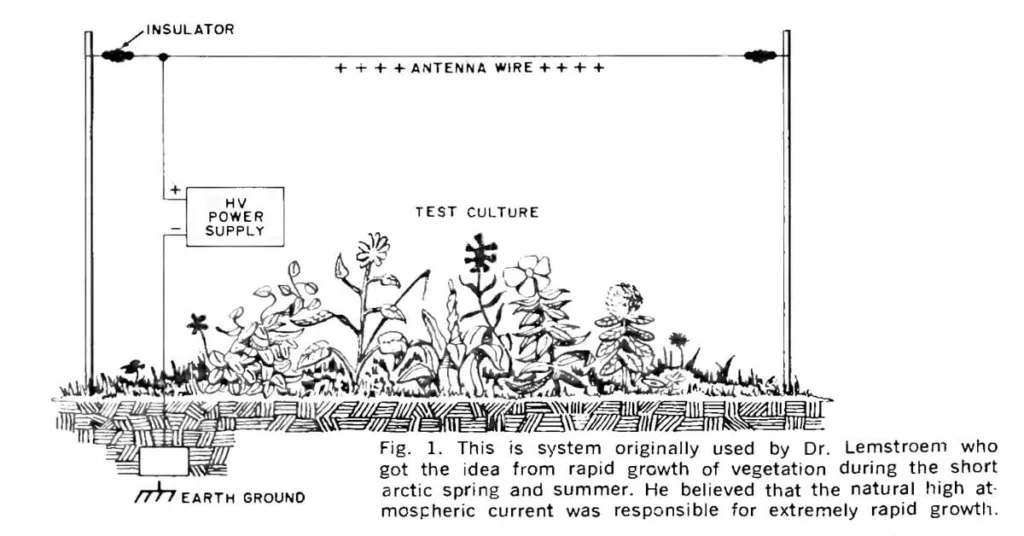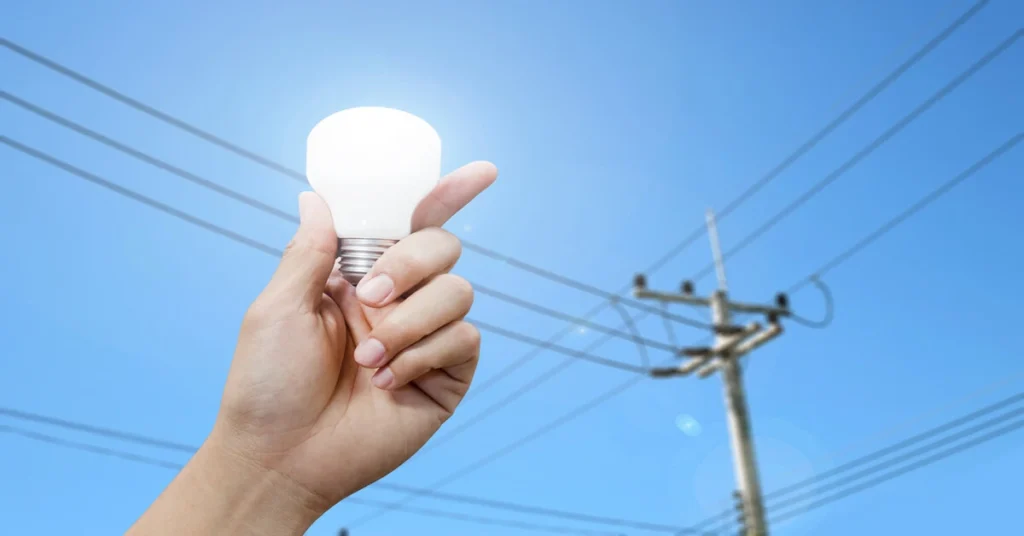Electroculture gardening is the use of electricity in agriculture to improve production. Electroculture is sometimes spelled electro-culture or electro culture. Many electroculture experiments have proven electricity can increase plant growth. However, scientists still aren’t exactly sure why electric currents improve plant growth.
This research began centuries ago but is still in its infancy. Many research results have contradicted one another. There have also been instances when positive results have been difficult to replicate by other researchers.
In this article, we’ll give a complete overview of electroculture gardening. We’ll start by explaining the basic concepts and then go over the history. We’ll also describe the advantages and disadvantages and how you can use it.
Quick Takeaway: Electroculture Gardening
Electroculture Overview:
- Electroculture gardening utilizes electricity to enhance plant growth, yield, and germination rates.
- Techniques include using generators, batteries, or solar panels alongside copper and zinc wires near plants, with varying voltage levels.
Historical and Current Studies:
- Research from the mid-1700s demonstrated electricity’s positive effects on plant development and blooming.
- Modern studies have shown improved seed germination, vegetative growth, and increased yield due to electric currents.
- Electricity has been found to increase micronutrients in the soil and enhance root mass and secondary metabolite biosynthesis in plants.
Challenges and Limitations:
- Lack of detailed implementation guidance limits the practical use of electroculture for non-experts.
- Diverse experimental setups and limited research make it hard to standardize effective methods.
- Some plants may respond negatively to electroculture, and the cost of equipment can outweigh yield benefits.
For Beginners:
- Beginners interested in electro culture should approach with caution due to varied results and techniques.
- DIY electroculture methods exist but are often unsupported by comprehensive research.
- Understanding the basics of electro gardening is essential before experimenting, considering both potential benefits and drawbacks.
What is Electroculture Gardening?
Electroculture gardening is the use of strong electric fields, or alternative sources of small air ions, to influence the growth of plants[12]. Using electric currents can improve the growth and yield of many plants. Researchers have come up with a variety of different methods for utilizing electricity in the garden.
Most methods involve using a power source such as a generator, battery, or solar panels. Copper and zinc wires are then run alongside plants throughout the garden. Once the power source is activated, the electricity runs through the wires to the plants.
Some methods require delivering higher voltages for short time periods each day. Others use a lower voltage for longer periods. Both methods have been shown to increase plant seed germination. They can also increase both vegetative growth and plant yields.
History of Electroculture
Studies regarding the impacts of electricity on plants began in the mid-1700s. In 1746, Dr. Maimbray of Edinburg used an electrostatic generator on myrtle plants. He showed the generator improved the plant’s development and blooming.
In 1748 Jean Nolet, a French abbot grew plants under charged terminals. He found it increased plant germination rates and their overall development rates.
Bernard-Germain-Étienne de La Ville-sur-Illon published Essay on Natural and Artificial Electricity in 1781. He describes watering plants with water that he infused with electricity. Plants given the electrified water germinated quicker and grew more vigorously.
Several other scientists continued experimenting with electrified water. The study of electro-culture changed when Alexander Bain invented the Earth battery in 1841. Plants grown between the zinc and copper plates grew faster and had higher yields.
The next big shift came in the 1880s. Professor Karl Selim Lemström began studying the effects of atmospheric electricity on plants. He published results in 1904 claiming atmospheric electricity increased yields. He also noted that it made plants sweeter and more aromatic[8].
In the late 1800s, many scientists also began looking at using antennas to harness atmospheric electricity. Father Pauling, the director of the Agricultural Institute at Beauvais began several experiments. He showed that his electroculture antenna improved the growth of potatoes and wine grapes.
In 1924, Blackman published a review of electroculture research[2]. Blackman then conducted several experiments showing the positive impacts of electro-culture on plants. This led many other scientists to begin studying electro culture themselves.
In the 1960s and 70s, several scientists began looking at ions in the air. Krueger, Kotaka, and Andriese (1964) showed that electricity interacted with air ions. They determined this could be why electroculture improved plant growth.
Since the 1980s, research regarding electroculture has become much more sophisticated. The results are more robust, renewing scientists’ interest in researching electroculture.
More studies are coming out each year showing that electroculture is a useful agricultural tool. Scientists are still trying to develop methods that are cost-effective for farmers and gardeners. Their progress is promising and may lead to farmers finally adopting this practice on a global scale.
Benefits Of Electro-culture Gardening
Many researchers have shown electro-cultivation to have several advantages. Most studies show that electricity can increase plant growth. Electricity can improve seed germination, speed up vegetative growth, and increase plant yield[7,9,13].
Electroculture doesn’t increase nitrogen or phosphorus significantly. However, it increases other nutrients to improve soil fertility. Studies have shown that electric currents can increase micronutrients in the soil. It increases aluminum, copper, magnesium, manganese, potassium, iron, sodium, and zinc[10,13].
In 2004, Fisher proved that electricity can increase the root mass of plants[5]. He noted that he isn’t sure why electricity led to better root development. Kaimoyo 2008, showed that electricity increases the biosynthesis of a plant’s secondary metabolites. He suggests this causes increased root growth[6].
Researchers have also had success killing, bacteria, and fungi in the soil using electricity[1]. In this way, electricity may lead to plants having increased resistance to pests and diseases. Using electricity to manage plant pests can help lead to reduced chemical use in farming.
Disadvantages Of Electroculture
One major disadvantage is the lack of awareness and understanding of how to use it. Studies often don’t provide enough detail regarding experimental setup. This prevents non-experts from understanding and implementing it themselves.
A handful of electroculture DIY articles exist. However, they are largely unsupported by research citations to support their methods.
Another disadvantage is the limited number of studies that have been done. Each study tends to use different electric sources, distances from plants, timing, and so on. This makes it difficult to determine which method is best which limits it’s use.
The limited number of experiments on various plants is also an issue. While electroculture has proven to be beneficial to some plants, it can harm others[11]. Therefore it can be risky to use electroculture on plant species that have not been used.
The equipment is expensive which is another disadvantage. Electoculture uses electricity which may cost more than the increased yield is worth. It often requires the use of copper which is also expensive.
How Electroculture Gardening Works
How electroculture gardening works is still a topic of debate among researchers. Some suggest electricity increases the amount of chlorophyll in plants. This allows them to produce more energy for growth through photosynthesis.
Others argue that it increases the amount of nutrients available in the soil. Therefore, plants have access to more nutrients, allowing them to grow better.
Others have shown that it improves the biosynthesis of plants. The electric currents increase their biosynthesis of secondary metabolites. This leads to improved root growth which in turn increases growth and seed germination.
Further research is needed to determine exactly how it works to improve gardening. Many scientists are working to better understand the underlying mechanisms.
How To Implement Electroculture
Researchers have developed all sorts of techniques. Some use generators, batteries, solar panels, and even wind-powered turbines. However, these techniques are not really practical for home gardeners due to how expensive they are.
A simple electroculture DIY technique that won’t break the bank is spiral antennas. Earth has a natural electromagnetic field that is present everywhere. The idea behind this method is to harness that energy to encourage better growth.
A simple way to implement this method is to create a small antenna. All you need is a wooden dowel and some copper or brass wire to get started. This method is an easy electroculture technique for beginners to create an electric garden.
Stick your wooden dowel several inches into the ground. You want it to reach just below where the mature plant’s roots will grow. The dowel should extend above ground to the height the plant is expected to grow.
After placing the dowel, wrap the wire around the end sticking out of the ground. You should try to wrap the wire at least nine times around the dowel.
There aren’t any scientific studies to support the use of this method. However, many gardeners claim they have seen significant increases in plant growth using antennas. Give it a try to see if this technique works for you.
Electroculture vs Magnetoculture
The main difference between electroculture and magnetoculture is the energy source they use. Electroculutre relies on electric currents to improve plant growth. Magnetoculture relies on harnessing magnetic field energy to improve plant growth.
Electroculture tends to be more expensive to implement than magnetoculture. You have to have a source of electricity such as a generator or solar panels. It also required the use of copper wires to deliver the electricity to plants which is expensive.
On the other hand, magnetoculture techniques can be rather cheap. Many only require the use of various-sized magnets to create a magnetic field around the plant. Both methods have been shown to increase growth in gardens.
Our Recommended Resources
Electroculture for Beginners Book
Electroculture Copper Plants Stakes/Antennas
Make your own Copper Electroculture Gardening Plant Antennas with this kit
References
[1] Artem, B., & Albertovna, T. T. (2012). The effect of electricity on plant growth. Journal Storage of Moscow, 65.
[2] Blackman, V. H. (1924). Field experiments in electro-culture1. The Journal of Agricultural Science, 14(2), 240-267.
[3] Dannehl, D. (2018). Effects of electricity on plant responses. Scientia Horticulturae, 234, 382-392.
[4] Electro-Culture. Nature 61, 602 (1900).
[5] Fischer, G., Tausz, M., Köck, M., & Grill, D. (2004). Effects of weak 16 3/2 Hz magnetic fields on growth parameters of young sunflower and wheat seedlings. Bioelectromagnetics, 25(8), 638-641.
[6] Kaimoyo, E., Farag, M. A., Sumner, L. W., Wasmann, C., Cuello, J. L., & VanEtten, H. (2008). Sub‐lethal levels of electric current elicit the biosynthesis of plant secondary metabolites. Biotechnology Progress, 24(2), 377-384.
[7] Lee, S., & Oh, M. M. (2021). Electric stimulation promotes growth, mineral uptake, and antioxidant accumulation in kale (Brassica oleracea var. acephala). Bioelectrochemistry, 138, 107727.
[8] Lemström, S. (1904). Electricity in agriculture and horticulture. ” The Electrician” Printing & Publishing Company, Limited.
[9] Neema, M., Hareesh, G. S., Aparna, V., Chandran, K. P., & Karun, A. (2022). Electrical Induction as Stress Factor for Callus Growth Enhancement in Plumular Explant of Coconut (Cocos nucifera L.). International Journal of Bio-Resource & Stress Management, 13(9).
[10] Murr, L. E. (1965). Biophysics of plant growth in an electrostatic field. Nature, 206(4983), 467-470.
[11] Pohl, H. A., & Todd, G. W. (1981). Electroculture for crop enhancement by air anions. International Journal of Biometeorology, 25, 309-321.
[12] Pohl, H. A. (1977). Electroculture. Journal of Biological Physics, 5(1-2), 3-23.
[13] Radhakrishnan, R., & Kumari, B. D. R. (2012). Pulsed magnetic field: A contemporary approach offers to enhance plant growth and yield of soybean. Plant Physiology and Biochemistry, 51, 139-144.


